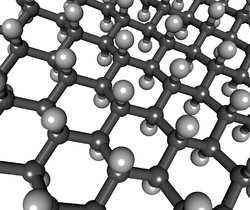Graphane
Graphane is a two-dimensional polymer of carbon and hydrogen with the formula unit (CH)n where n is large. Graphane should not be confused with graphene, a two-dimensional form of carbon alone. Graphane is a form of hydrogenated graphene. Graphane's carbon bonds are in sp3 configuration, as opposed to graphene's sp2 bond configuration, thus graphane is a two-dimensional analog of cubic diamond.
 | |
| Identifiers | |
|---|---|
| ChemSpider |
|
| Properties | |
| (CH)n | |
| Molar mass | Variable |
Except where otherwise noted, data are given for materials in their standard state (at 25 °C [77 °F], 100 kPa). | |
| Infobox references | |
Structure
The structure was found, using a cluster expansion method, as the most stable of all the possible hydrogenation ratios of graphene in 2003.[1] In 2007, researchers found that the compound is more stable than other compounds containing carbon and hydrogen, such as benzene, cyclohexane and polyethylene.[2] This group named the predicted compound graphane, because it is the fully saturated version of graphene. The compound is an insulator. Chemical functionalization of graphene with hydrogen may be a suitable method to open a band gap in graphene.[2]
P-doped graphane is proposed to be a high-temperature BCS theory superconductor with a Tc above 90 K.[3]
Any disorder in hydrogenation conformation tends to contract the lattice constant by about 2.0%.[4]
Variants
Partial hydrogenation leads to hydrogenated graphene rather than (fully hydrogenated) graphane.[5] Such compounds are usually named as "graphane-like" structures. Graphane and graphane-like structures can be formed by electrolytic hydrogenation of graphene or few-layer graphene or high-oriented pyrolytic graphite. In the last case mechanical exfoliation of hydrogenated top layers can be used.[6]
Hydrogenation of graphene on substrate affects only one side, preserving hexagonal symmetry. One-sided hydrogenation of graphene is possible due to the existence of ripplings. Because the latter are distributed randomly, the obtained material is disordered in contrast to two-sided graphane.[5] Annealing allows the hydrogen to disperse, reverting to graphene.[7] Simulations revealed the underlying kinetic mechanism.[8]
Density functional theory calculations suggested that hydrogenated and fluorinated forms of other group IV (Si, Ge and Sn) nanosheets present properties similar to graphane.[9]
Potential applications
Graphane has been proposed for hydrogen storage.[2] Hydrogenation decreases the dependence of the lattice constant on temperature, which indicates a possible application in precision instruments.[4]
References
- Sluiter, Marcel H.; Kawazoe, Yoshiyuki (2003). "Cluster expansion method for adsorption: Application to hydrogen chemisorption on graphene". Physical Review B. 68 (8): 085410. Bibcode:2003PhRvB..68h5410S. doi:10.1103/PhysRevB.68.085410.
- Sofo, Jorge O.; Chaudhari, Ajay S.; Barber, Greg D. (2007). "Graphane: A two-dimensional hydrocarbon". Physical Review B. 75 (15): 153401. arXiv:cond-mat/0606704. Bibcode:2007PhRvB..75o3401S. doi:10.1103/PhysRevB.75.153401.
- Savini, G.; Ferrari, A. C.; Giustino, F. (2010). "First-principles prediction of doped graphane as a high-temperature electron-phonon superconductor". Physical Review Letters. 105 (3): 037002. arXiv:1002.0653. Bibcode:2010PhRvL.105c7002S. doi:10.1103/PhysRevLett.105.037002. PMID 20867792.
- Feng Huang, Liang; Zeng, Zhi (2013). "Lattice dynamics and disorder-induced contraction in functionalized graphene". Journal of Applied Physics. 113 (8): 083524. Bibcode:2013JAP...113h3524F. doi:10.1063/1.4793790.
- Elias, D. C.; Nair, R. R.; Mohiuddin, T. M.; Morozov, S. V.; Blake, P.; Halsall, M. P.; Ferrari, A. C.; Boukhvalov, D. W.; Katsnelson, M. I.; Geim, A. K.; Novoselov, K. S. (2009). "Control of graphene's properties by reversible hydrogenation: Evidence for graphane". Science. 323 (5914): 610–3. arXiv:0810.4706. Bibcode:2009Sci...323..610E. doi:10.1126/science.1167130. PMID 19179524.
- Ilyin, A. M.; Guseinov, N. R.; Tsyganov, I. A.; Nemkaeva, R. R. (2011). "Computer simulation and experimental study of graphane-like structures formed by electrolytic hydrogenation". Physica E. 43 (6): 1262. Bibcode:2011PhyE...43.1262I. doi:10.1016/j.physe.2011.02.012.
- Novoselov, Konstantin Novoselov (2009). "Beyond the wonder material". Physics World. 22 (8): 27–30. Bibcode:2009PhyW...22h..27N. doi:10.1088/2058-7058/22/08/33.
- Huang, Liang Feng; Zheng, Xiao Hong; Zhang, Guo Ren; Li, Long Long; Zeng, Zhi (2011). "Understanding the Band Gap, Magnetism, and Kinetics of Graphene Nanostripes in Graphane". Journal of Physical Chemistry C. 115 (43): 21088–21097. doi:10.1021/jp208067y.
- Garcia, Joelson C.; De Lima, Denille B.; Assali, Lucy V. C.; Justo, João F. (2012). "Group-IV graphene- and graphane-like nanosheets". Journal of Physical Chemistry C. 115 (27): 13242–13246. arXiv:1204.2875. Bibcode:2012arXiv1204.2875C. doi:10.1021/jp203657w.